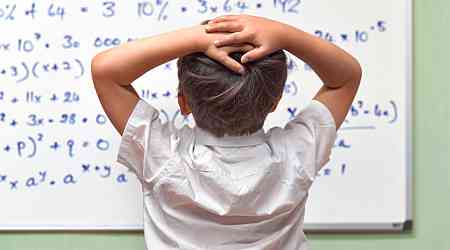
Across the nation, kids are heading back to school. It’s an exciting time. I remember both the joy and the nervousness that came with my now twin 13-year-olds’ first starting school. In fact, one day in particular stands out.
I was rushing to the school, late as usual. As I hustled up four flights of stairs to their classroom, another parent interrupted my thoughts and started talking.
“She’s like me, basically,” the woman said. “She’s just not a math kid. We are creative types.”
[time-brightcove not-tgx=”true”]I looked up, startled; I couldn’t hide my reaction. Here was a mom, already ruling out an entire world of possibilities for her child whose education had barely begun. Imagine if we treated reading in the same manner.
The experience I had at pick-up is far from unique. As a math learning expert, I understand how deeply ingrained the myth of the math kid is in our education system. We classify or sort kids based on our perception of their varied, inborn math ability—”math kids” on one side, everyone else on the other.
This view ignores the science that says all humans have an inherent number sense and ability to think mathematically from the start. In fact, scientists have proven that babies and toddlers show and develop numeracy—the ability to understand and work with numbers—early on. Babies only a few days old can distinguish two from three.
As school starts again, it’s time to bust the myth of the math kid. In particular, the widespread misconceptions that speed in math is paramount, math is a series of tricks, and only a single way exists to solve a problem.
Myth # 1: Math is only about speed
If you’re like most Americans, you’ll remember the joy (the terror!) of timed multiplication tests. A sprint to the finish. Even if you did well on these timed tests, the moment the teacher said, “Begin,” hearts raced and stomachs churned.
Let me be clear: The ability to call upon key facts and skills quickly—developing fluency—is vital in math. It frees up working memory to tackle a hard problem in front of us. Early on, however, this type of overemphasis on speed ends up convincing students that math is only for the fastest students.
Additionally, as students progress to more advanced mathematics, they will need more than speed. They need the ability to approach problem solving in a calm, methodical way to ensure accuracy.
Take for instance a study by Dartmouth College President Sian Leah Beilock, Ph.D., comparing two groups tasked with solving problems under time pressure: one group consisted of physics graduate students and professors, and the other, undergraduates who had completed just one physics class. Researchers assumed that the graduate students and professors would finish more quickly and accurately. To no one’s surprise, the graduate students and professors were much more accurate. They, however, took longer to complete the problems. Their more rigorous approach involved a long, upfront pause to deeply understand the problem and consider the best approach before diving into problem solving.
Read More: How to Help Your Kid With Math Even if You Suck at it
In overemphasizing speed, kids assume they don’t belong in math—reinforcing the myth of the math kid—and don’t advance their problem-solving abilities. Speed counts for something—just not for everything.
Myth # 2: Math is more than a series of tricks
Teaching math as a set of tricks tells kids that we don’t think they can understand what’s on the board. As with focusing too much on speed, this approach de-prioritizes any chance for deep understanding of math concepts and development of their problem-solving abilities.
Take “anything times zero is zero.” This is a common trick we have kids memorize. Why is that true? Most kids will say, “It’s just a rule.” In fact, most adults will too. This unquestioning acceptance not only limits understanding, but also undermines common sense.
Consider instead visualizing this multiplication problem as cookies on plates. 3 × 1 means you have 3 plates, each plate with 1 cookie. That is 3 cookies altogether. And 3 × 3 means you still have 3 plates, but each plate has 3 cookies. That is 9 cookies altogether.
Now express 3 × 0 in plates and cookies. Okay, that is 3 plates. And how many cookies are on each plate? Zero. So now instead of 3 plates with 3 or 9 warm, gooey cookies, I have zero cookies in total. No cookies!
This visualization helps kids understand math more deeply, ensuring durable comprehension, which, unlike tricks, students can rely on. Students can also learn practical skills like estimating answers or developing an intuition for when we are wrong. This approach demystifies math, making it both accessible and rigorous to all students, not just the so-called “math kids.”
Myth # 3: There is no one right way to do math
Finally, kids often believe that only one correct way exists to solve a problem and focus on getting to a quick answer. When they inevitably get stuck, this misconception discourages them from exploring alternative ways to solve a problem.
Consider a middle-school word problem: A store is selling 6 bags of marbles for $18. What is the unit price for a bag of marbles? I have visited hundreds of math classrooms across the nation. Many times when a kid gets this type of question, they look up and ask: “Does ‘of’ mean multiplication?” This search for keywords like “of” is in the name of looking for a “single way” to solve the problem.
Real-world problem-solving involves exploring various strategies. For instance, if you lose your keys, you might retrace your steps, visualize where you last had them or check unusual places. Some of these may lead to dead ends, but a variety of techniques are likely to lead to finding your keys.
Let’s reimagine the marble problem. Instead of looking for keywords, imagine a picture in your mind. A store has a bin full of marble bags and a sign that reads “6 bags for $18.” If interested in just one bag, a customer would naturally calculate the price by dividing $18 by 6. Here, “of” simply describes what’s in the bags — it does not indicate multiplication. This kind of thinking shifts the focus to understanding, highlighting multiple ways to approach a problem.
When the preschool mom casually dismissed her daughter’s math ability, she may not have been thinking about these myths, but she was parroting the prevailing narrative of the math kid. But it doesn’t have to be this way. Instead, we can give kids—even preschoolers—the chance to hone their problem-solving skills, to develop deep understanding, and to utilize their inborn ability to think mathematically. Because, in reality, all kids are math kids.



























